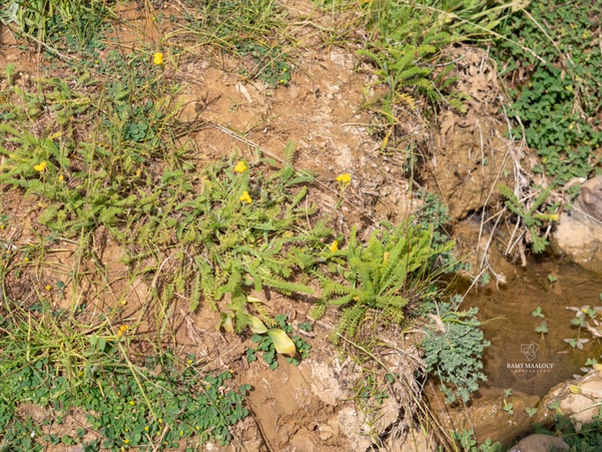Family |
Asteraceae
Tanacetum aucheri
DC.
Leb. Syr. Tur.
Tanacetum aucheri DC.
(Prodr. 7: 298; 1838 – Nouvelle Flore du Liban et de la Syrie, vol. 2, Pl. CCXXXI nº 3; 1969)
• Life-form & habit: Perennial herb with woody base, 20–50 cm tall, forming dense tufts of erect to ascending stems covered in greyish tomentum. Whole plant strongly aromatic when crushed.
• Leaves: Alternate, pinnatisect to bipinnatisect, 5–15 × 2–5 cm, segments linear-lanceolate, acute, entire or slightly lobed; both surfaces densely tomentose, giving a silvery-grey appearance. Basal leaves petiolate; upper leaves sessile, smaller, semi-amplexicaul.
• Inflorescence & flowers: Corymbose capitulescence with 10–25 hemispheric capitula, each 1–1.5 cm across. Involucre hemispherical, phyllaries imbricate in several series, outer shorter, grey-tomentose; inner with scarious margins. Florets all tubular, yellow, hermaphrodite or functionally female; ray florets absent. Receptacle naked.
• Fruit: Achenes oblong, ribbed, glabrous, 1.5–2 mm long; pappus absent or reduced to a short rim.
• Phenology: Flowers and fruits from June to August.
• Habitat & elevation: Rocky slopes, steppe margins, and dry montane grasslands on limestone or marl, 1 200–2 400 m. Prefers open, sunny habitats in subalpine and upper montane zones.
• Lebanese distribution: Recorded by Mouterde from the high mountains of Mount Lebanon — especially between Dahr el-Baïdar, Barouk, Sannine, and Makmel. Locally common in open rocky habitats within the cedar belt and alpine steppe.
• Native to: Lebanon, Syria, Türkiye (POWO).
• ⚠️ Taxonomic note: A Levantine–Anatolian montane species belonging to the Tanacetum densum complex. Readily recognised by its silvery tomentose foliage, absence of ray florets, and strong aromatic scent. Distinguished from T. densum subsp. amanii by its smaller heads, longer leaves, and denser indumentum. In Lebanon, T. aucheri is a characteristic element of high limestone slopes and subalpine steppe vegetation, often associated with Origanum ehrenbergii, Astragalus cruentiflorus, and Acantholimon species.









